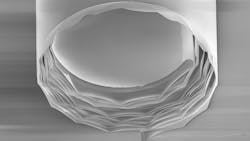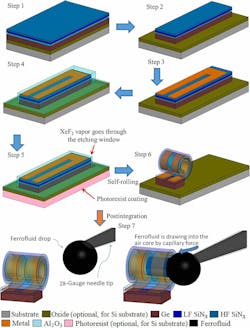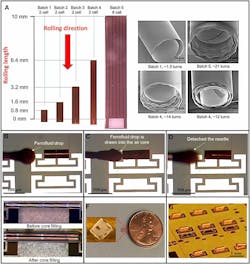High-Performance Inductor on a Chip: More than a Metallic Spiral
Creating a basic inductor on a substrate sounds easy—just metallize the substrate, preferably with a spiral, serpentine, or other pattern. While traditional microchip inductors are relatively large 2D spirals of wire, a team at the University of Illinois Holonyak Micro and Nanotechnology Laboratory boosted the performance of its previously developed 3D inductor technology by up to three orders of magnitude using a more sophisticated technique.
Their monolithic-on-sapphire non-MEMS approach uses a fully integrated, self-rolling, multilayered thin-wall copper tube filled with magnetic nanoparticles. The process, compatible with 2D semiconductor processing, created a condensed magnetic field distribution and energy-storage device in 3D space.
The team achieved inductance of 1.24 µH at 10 kHz for a single microtube inductor, with areal and volumetric inductance densities of 3 µH/mm2 and 23 µH/mm3, respectively. They also graphically characterized their Q (quality factor) and performance to 10 MHz. (In addition, they measured the magnetic strength of their inductors in microTesla, but those values are harder to relate to standard circuit-component parameters.)
The first improvement was to work with the copper rolled tubes in the vapor phase. These tubes aren’t merely simple, single-layered tubes like drinking straws, but instead are multi-turned cylindrical rolls. Project leader Prof. Xiuling Li noted that, “Previously, the self-rolling process was triggered and took place in a liquid solution. However, we found that while working with longer membranes, allowing the process to occur in a vapor phase gave us much better control to form tighter, more even rolls.” The result is what they call a self-rolled-up membrane (S-RuM).
The second innovation was to create an iron core within the tubes. Li noted “The most efficient inductors are typically an iron core wrapped with metal wire, which works well in electronic circuits where size is not as important of a consideration. But that does not work at the microchip level, nor is it conducive to the self-rolling process, so we needed to find a different way.” To do this, they filled the already-rolled membranes with an iron-oxide nanoparticle solution using a tiny dropper (Fig. 1).
Due to capillary pressure, the droplets of the solution are “sucked” into the tube cores. The solution then dries while the iron nanoparticles remain inside the tubes, creating an analog to conventional solid-iron cores (Fig. 2).
This isn’t their first inductor effort. Previously, they developed 3D inductors using 2D processing by using a “rolled membrane” approach where wire spiraled out of plane and was separated by an insulating thin film from turn to turn. Those wire membranes, when unrolled, were 1 mm long but took up 100 times less space than the traditional 2D inductors. In contrast, these improved wire membranes have about 10X that length at 1 cm, yielding more turns and higher inductance in about the same amount of space.
Their lengthy paper “Monolithic mtesla-level magnetic induction by self-rolled-up membrane technology” (with 22 authors!) was published in Science Advances, along with equally detailed Supplementary Materials. There are also two short videos—one shows the rolling progress of a 1-cm-long microinductor and the other shows the ferrofluid-filling process for a short rolled microinductor:
Also participating in this study, which was supported by The National Science Foundation Engineering Research Center for Power Optimization of Electro-Thermal Systems and the U.S. Department of Energy, were researchers from Stanford University, Hefei University of Technology, China, and the University of Twente, The Netherlands.
About the Author

Bill Schweber
Contributing Editor
Bill Schweber is an electronics engineer who has written three textbooks on electronic communications systems, as well as hundreds of technical articles, opinion columns, and product features. In past roles, he worked as a technical website manager for multiple topic-specific sites for EE Times, as well as both the Executive Editor and Analog Editor at EDN.
At Analog Devices Inc., Bill was in marketing communications (public relations). As a result, he has been on both sides of the technical PR function, presenting company products, stories, and messages to the media and also as the recipient of these.
Prior to the MarCom role at Analog, Bill was associate editor of their respected technical journal and worked in their product marketing and applications engineering groups. Before those roles, he was at Instron Corp., doing hands-on analog- and power-circuit design and systems integration for materials-testing machine controls.
Bill has an MSEE (Univ. of Mass) and BSEE (Columbia Univ.), is a Registered Professional Engineer, and holds an Advanced Class amateur radio license. He has also planned, written, and presented online courses on a variety of engineering topics, including MOSFET basics, ADC selection, and driving LEDs.


